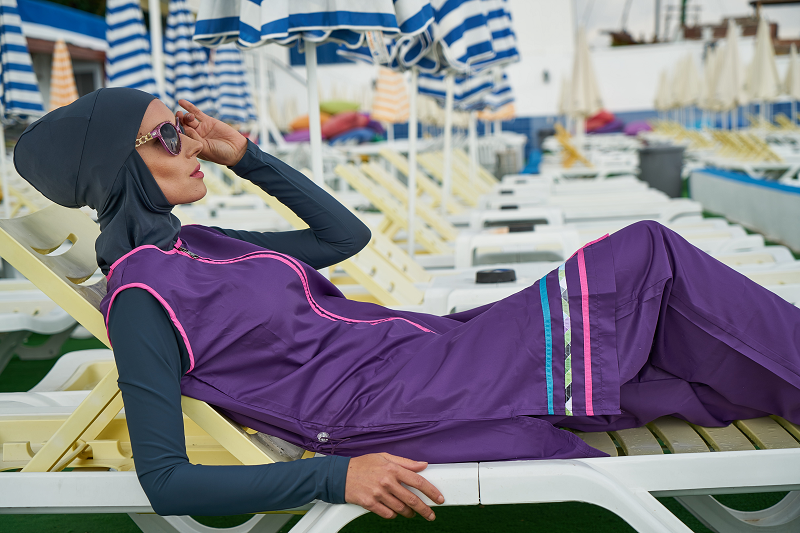12 Religion
Module Learning Objectives (MLO)
In this chapter, you will
- MLO 12.1 Identify foundational concepts related to religion, fashion, identity, appearance, and dress. [CLO 1]
- MLO 12.2 Identify different types of dress worn by people following different oppressed religions in the United States. [CLO 1]
- MLO 12.3 Identify people following different oppressed religions experiences in the United States wearing different dress objects reflecting their religious identities. [CLO 1]
- MLO 12.4 Identify different fashion brands that produce and sell dress objects for people following different oppressed religions in the United States. [CLO 2]
- MLO 12.5 Explain the role of dress and appearance in the development of one’s religious identity in the United States. [CLO 2]
- MLO 12.6 Examine how dress and appearance of people following different oppressed religions in the United States are represented in the fashion system (e.g., advertisements or retailers). [CLO 3]
- MLO 12.7 Examine social justice issues related to dress and appearance for people following different oppressed religions in the United States. [CLO 3]
- MLO 12.8 Deconstruct your own perspectives and approach to understanding the dress and appearance of people following different oppressed religions in the United States. [CLO 4]
- MLO 12.9 Identify the driving forces of transformative social justice change in the fashion system related to oppressed religious groups in the United States. [CLO 5]
A religion is a set of beliefs, symbols, and practices based on the idea of the sacred (which people define as extraordinary, inspiring a sense of awe and reverence) and unites believers in a socioreligious community. There are over 4,000 religions worldwide, and more than 80% of the world’s people are religiously affiliated. This includes
- 2.2 billion Christians (32%)
- 1.6 billion Muslims (23%)
- 1 billion Hindus (15%)
- 500 million Buddhists (7%)
- 14 million Jews (0.2%)
In addition, more than 400 million people (6%) practice various folk or traditional religions, including African traditional religions, Chinese folk religions, Native American religions, and Australian aboriginal religions. An estimated 58 million people—slightly less than 1% of the global population—belong to other religions, including, for example, the Baha’i faith, Jainism, Sikhism, Shintoism, Taoism, Tenrikyo, Wicca, and Zoroastrianism.
Among those living in the United States, 77% of adults identify with a religious faith. Even within a single religion, there are varying interpretations of dress. For example, Reform and Orthodox Jews have different customs or rules of dress, as do Mennonites (a Christian denomination) and Baptists (another Christian denomination).
Muslim Dress
There is a common misconception that all Arab people are Muslims, meaning they follow the religion of Islam. However, many Arabs follow Christian, Jewish, or other, less popular religions. After all, Arabs are simply people who speak Arabic as a native language. This encapsulates a wide swath of individuals from 22 different countries, from Morocco to Oman. (Further, Muslims are found around the world, with most Muslims residing in Asia and in Pacific regions, not the Middle East or Africa.)
The concept of modesty is central to Muslim dress for both men and women. That is, Muslim people often dress in clothing that does not reveal parts of the body. This might mean wears looser clothing or clothing that covers most of the skin. For example, a Muslim man might wear a thobe, a long, loose- fitting robe that is usually white in color. A Muslim man also might incorporate head coverings into his dress, such as a ghutra, a square or rectangular headscarf, with an igal, a cord that holds the ghutra in place.

Elements of Muslim women’s dress include
- burka: a veil that covers the entire body and face, with mesh over the eyes that the wearer can see through.
- niqab: a veil that covers the head and face, but not the eyes. The niqab is usually worn paired with a long, loose black garment, called an abaya, that falls to cover the feet.
- chador: a cloak that covers the body from head to toe but leaves the face uncovered. The chador is popular among Iranian women.
- dupatta: a long scarf draped across the head and shoulders and often paired with matching garments. The dupatta is common in South Asian countries.
- hijab: a general term meaning “to veil”; hijab commonly refers to a headscarf that covers the hair and neck of the wearer, but not the face.
The Burkini: Design, History, and Controversies
The burkini is a full-body swimsuit that includes long sleeves, long pants, and a hood, in an all-in-one design. Some, but not all Muslim women wear the burkini; there are different perspectives and interpretations of modesty within the Muslim community. There are a lot of different styles for the burkini, and numerous retailers sell them (Ahiida.com). The burkini is rather similar to a surfer’s wet suit in design and overall look.

The burkini was designed in 2006 by a Lebanese woman who lives in Australia, Ahiida Zanetti. It was originally made for lifeguards in Australia and has since spread and been worn by numerous Muslim women across the world (Akou, 2013). In 2019, Sports Illustrated featured the first model wearing a burkini. However, there was much controversy over whether a Muslim woman practicing modest dress should model in Sports Illustrated, a magazine that historically has featured women in sexualized and objectified poses (Sini, 2019).
The burkini is not the only sports-related dress to consider Muslim women and their religious needs. In 2017, Nike designed and introduced the Nike Pro Hijab for female Muslim athletes. Ibtihaj Muhammad, a champion fencer and Nike athlete, has described some of the issues she faced being a young Muslim girl and being active: “When I was in school, I always had to have a letter from a local imam that said that it was safe for me to wear my religious covering during sport. . . . My coaches had to have that with them at all times” (Nike.com, 2017).” In a University of Minnesota research project, scholars worked with Muslim women and young girls and inquired about their design needs for athletic wear. The young Muslim girls codesigned the clothing with the researchers to meet their athletic and religious needs. There’s a short video in the reference link at the end of the sentence that documented some of this process of this research project: “New Uniforms Score Points for Modesty for Muslim Girls (Satzinger, 2015)”
After the introduction of the burkini, some areas in France began banning the swimsuit for Muslim women (Dearden, 2016). Once the bans were in place, onsite security or police officers required some Muslim women to remove their burkini in public. The ban is related to France’s overall move toward the separation of religion and state. France’s secular principle introduced into law on March 15, 2004, prohibits any clothing or other religious attire being worn in schools (France Diplomacy, n.d.).
Controversy over modest swimwear was not limited to France. In 2016, in the United States, in New Jersey, Muslim women swimming in public spaces said they received stares of confusion, and another group of women was not admitted to a public pool because the pool officials stated the burkini was a safety hazard (Alex & Alvarado, 2016).
Watch this short film about Muslim women’s dress.
Both Muslim men and women, however, engage varying degrees of modest dress. Some Muslim women might cover more of their bodies than others, and some might dress more modestly in public but not in the privacy of their own homes.
Jewish dress
Similar to Muslim dress, the dress of Jewish people can differ widely, from liberal to highly conservative presentations. Even Conservative Jews are less strict in their dress than Orthodox Jews, however.
Watch this short film about Judaism, Reform Jews, identity, and dress.
Orthodox Jewish Dress
Orthodox Jews highly value modesty; some Jewish Orthodox women wear wigs, or sheitel, to ensure their modesty while allowing them to still fit into mainstream US culture. Orthodox Jewish men wear skullcaps, yarmulkes, or kippah to cover their heads. They do so is because the Talmud (the body of Jewish civil and ceremonial law) argues that because there is divine presence over one’s head, you should cover your head to show respect to that divine presence, Hashem (God).
Hasidic Jewish Dress
Hasidic Jewish men might wear even more religion-specific garments, such as a fur hat (shtreimel), a curled lock of hair on each side of the head (payot), and a black prayer belt (gartel).
Watch this short film to learn more about Hasidic style.
To access a transcript for the video above, download this document: Hasidic Style Video Transcript [DOC]
Mennonites (Christian)
Mennonites follow the Anabaptist sect of the Christian faith, a group that rejected baptism of infants and insisted baptism should only occur when one is certain that they are a believer. This group often follows a conservative dress style, with a particular focus on women’s modesty. For example, some women cover their hair with a starched cap, which represents the woman’s humility to God and her resistance to worldly possessions. This cap also represents submissiveness to God, the woman’s community, and her husband.

Watch this short video to see a 1960s Mennonite dress worn by a woman in Iowa. The dress is part of the ISU Textiles and Clothing Museum permanent collection.
Buddhist Dress
Buddhism, Hinduism, Taoism, and Shintoism are all polytheistic religions (religions whose followers believe in many gods) represented in the United States. Their representatives follow particular manners of dress. In this section, we’ll be reviewing Buddhist dress.

Buddhism, which originates in India, stresses that material possessions do not bring happiness, but rather, true happiness comes from within oneself. Following this line of belief, fully ordained Buddhist monks wear robes, or kasayas, simple garments colored a bright orange with saffron. Today, 5–6 million Buddhists live in the United States.
Sikh Turbans and Gucci
Sikhism is a monotheistic religion that originated in India. Members of this religion are referred to as Sikhs. According to a 2012 Pew Research Center report, there are about 500,000 Sikhs living the United States (Rosentiel, 2012).
Rupinder Singh, who follows the Sikh religion discusses how his religion is reflected in his dress. Read about his experience in this article: “11 Things You Wanted to Know About My Turban but Were Too Afraid to Ask” (2021). The turban is one way that people who follow the Sikh religion symbolize their religion through their dress.
After you read Rupinder’s article, watch this short video : “How to Tie a Traditional Sikh Turban” (British Museum, 2011). It highlights one way a Sikh person can tie a turban.
In 2019, Gucci, an international high-fashion brand introduced a “fashionable turban” into its collection. The bright blue turban appeared to be styled very similarly to Sikh turbans. There was significant backlash against Gucci for producing and selling the $800 turban. One Washington Post article discussed how the Gucci turban was an inappropriate form of cultural appropriation (Chiu, 2019).
Required reading
The Sikh Coalition. (n.d.). Identity. Retrieved from https://www.sikhcoalition.org/about-sikhs/identity/

Religion Case Study
Step One: Become familiar with the case study.
- The case study attached below is a Word document and can be downloaded. It includes the task, evaluation, and template for the case study:
Step Two: Submit your complete assignment on Canvas.
- Format your document.
- Remember to check the submission against the rubric.

